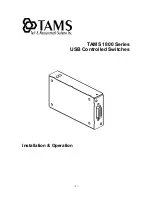
43
transmitted.
IP addresses appear in dotted decimal (rather than in binary) notation. Dotted
decimal notation divides the 32-bit value into four 8-bit groups, or octets, and
separates each octet with a period. For example, 199.217.132.1 is an IP address in
dotted decimal notation.
To accommodate networks of different sizes, the IP address has three divisions –
Classes A for large, B for medium and C for small. The difference among the
network classes is the number of octets reserved for the network ID and the number
of octets reserved for the host ID.
Class
Value of First
Octet
Network ID
Host ID
Number of
Hosts
A
1-126
First octet
Last three octets 16,387,064
B
128-191
First two octets
Last two octets
64,516
C
192-223
First tree octets
Last octet
254
Any value between 0 and 255 is valid as a host ID octet except for those values the
InterNIC reserves for other purposes
Value
Purpose
0, 255
Subnet masking
127
Loopback testing and interprocess communication on local devices
224-254 IGMP multicast and other special protocols.
Subnetting and Subnet Masks
Subnetting divides a network address into sub-network addresses to accommodate
more than one physical network on a logical network.
For example:
A Class B company has 100 LANs (Local Area Networks) with 100 to 200 nodes on
each LAN. To classify the nodes by its LANs on one main network, this company
segments the network address into 100 sub-network addresses. If the Class B
network address is 150.1.x.x, the address can be segmented further from 150.1.1.x
through 150.1.100.x
A subnet mask is a 32-bit value that distinguishes the network ID from the host ID for
different sub-networks on the same logical network. Like IP addresses, subnet
masks consist of four octets in dotted decimal notation. You can use subnet masks
to route and filter the transmission of IP packets among your sub-networks. The
value “255” is assigned to octets that belong to the network ID, and the value “0” is
assigned to octets that belong to the host ID.
For the example above, if you want all the devices on the sub-networks to receive
each other’s IP packets, set the subnet mask to 255.255.0.0. If you want the devices
on a single sub-network only to receive IP packets from other devices on its own sub-
network, set the subnet mask to 255.255.255.0 for the devices on the sub-network.
Subnet Mask
Routing and Filtering
0.0.0.0
IP packets are transmitted to all devices.








































